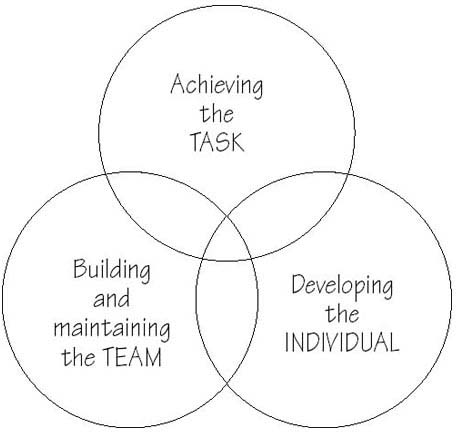5 Reading 4 Leadership
5.1 The leader's role
This reading is concerned with the relationship between the leader and his or her subordinates and the effectiveness of different approaches to this relationship.
First I will examine the leader's role, in an attempt to answer the question of why we need leaders. Then I will examine the issue of authority, and the tensions and potential conflicts that relate to this issue. Next, I will consider some of the theories that have been put forward about leadership. What makes a leader? What makes one leader more effective than another? Are leaders born or made? Can anyone learn how to be a leader? Though there are no simple answers to these questions, the discussion gives some useful insights into the complex nature of leadership.
In the traditional hierarchical organisation, run according to scientific management principles, the leader's role was clear. It was to plan, monitor and control – in general to get people to behave so as to further the organisation's aims. In more democratic organisations the role of the leader changes. Indeed, some people question why groups of well-motivated and knowledgeable people need a leader at all.
Yet, it is a common experience that when a group of people get together in order to perform a task, some form of leadership pattern tends to emerge spontaneously. It may not involve someone being called 'leader', 'manager' or whatever – labels such as: coordinator, facilitator, representative, chairperson, etc. may be used, or there may be no label used at all. It may also involve more than one person, perhaps with different parts of the role being split between different people or moving from person to person. Nevertheless, the leadership function still tends to be filled, whether or not the group formally recognises it. Indeed it is possible to have a group that shows a severe conflict between a conscious denial of the validity of the leadership on ideological grounds, combined with an unconscious need for a leadership function, leading to a high level of insecurity, even paranoia, coupled with a low level of effectiveness.
Leadership roles are, of course, an important issue in gender politics. It is often argued that the hierarchical, leader-oriented structures tend to be emphasised in male-dominated societies, while women tend to prefer flatter, network-based structures.
Certainly, in more democratic organisations, the leader's role tends to retain the functions of integrating, organising, coordinating and representing the group, but changes from supervising to facilitating. It is possible for the role of leader to be shared; indeed it is unlikely that any one individual will have all the necessary skills to meet all of a group's demands all of the time. However, for a group to function effectively, it is necessary for all aspects of the leadership role to be fulfilled. It is also worth emphasising that most leadership roles require the individual involved to serve the group, not to control or dominate it. For example, chairpersons are required to put aside their own interests in meetings and pay full attention to the discussion, so as to be able to pull points together, sense when the discussion is getting bogged down and recognise when a conclusion has been reached: if they were to focus their energies on imposing their own solutions or conclusions, they would be failing in their role as leaders.
Adair (1983) sees the role of the leader as composed of three overlapping areas of responsibility: achieving the task, building and maintaining the team, and developing the individual (see Figure 9). The first responsibility of the leader, according to Adair, is to define the objectives to achieve the task, to focus and coordinate team effort. Building and maintaining the team involves fostering constructive relationships between team members. Developing the individual includes assigning personal goals that suit the strengths and skills of the individual, and ensuring that each member feels that his or her contribution to the team's overall task is valued.

The tensions involved in a group between the need for the leadership role to be filled and the desire for democracy are well illustrated in Box 4.1. This is an extract from a study of the relationships between members of a particularly intensive and specialised form of work group, the string quartet. The study examined the characteristics that distinguish the more successful from the less successful groups. It concluded that the best groups were those with leaders who accepted their leadership responsibilities but recognised the vital contribution of each member of the group, and led with a light touch. This conclusion supports the point made at the end of the last paragraph but one, that the leader's role is usually to serve rather than dominate the group.
Box 4.1 The string quartet
String quartets are particularly intense work groups. Members are reciprocally interdependent using each other's outputs as their own inputs, and vice versa. Their interdependence is also complete and immediate. Their work is done only as a unit; they cannot perform a string-quartet composition without all of the members working together simultaneously. They are artists who collaborate; they must simultaneously devote their concentration to their own and to each other's playing.
A string quartet is composed of two violinists, a viola player, and a cellist; their collective task is to reach a high level of coordinated sound … The first violinist is the musical leader of the quartet … The first violinists' parts are usually the most difficult … Among the four players, he or she gets the most attention and acclaim; many quartets, for example, are named after their first violinists …
While traditional string-quartet pieces demand that the first violin [dominates] the music, they also require a complementary but nevertheless engaging sound from the second violinist. For a quartet to do well, the second violinist cannot get lost in the background. The viola player teams with the second violinist to form the 'middle' of the quartet … The cellist is literally and figuratively the base of the group, laying the foundation above which the tonally higher strings can shine … The best quartets ask each player to have a soloist's skills but not a soloist's temperament.
All string quartets face two conflicting facts: (1) Quartet music typically gives the lead (i.e. most of the good music) to the first violinist; and (2) the players reported that they joined the quartet to have a voice in how they play. Members of orchestras, for instance, are bound by the conductor's decisions. Each member of a string quartet, however, can theoretically have one-fourth of the input in musical and business decisions. Members share equally in their concert fees and expect to share equally in intragroup influence. At the same time, the first violinist has most of the musical opportunities and responsibilities in traditional compositions. This also extends to the group's everyday business interactions: since first violinists are the most well-known and recognised members of each quartet, they are often pressed to act as the group's primary speaker and public relations person …
Most quartet members used the words 'leader' and 'first violinist' almost interchangeably. All of the top groups recognised that their task demanded a leader and that that person was naturally the first violinist. Many first violinists explicitly recognised the leader-democracy paradox … members of the top groups either acknowledged both sides of the paradox or viewed the situation as being very democratic. One second fiddle said, 'He does dominate; he's an extrovert anyway. He likes central attention. And obviously that's very good for a first fiddle.' A little later in the same interview he said, 'We're fairly equal as far as decisions.' A cellist described the paradox metaphorically, emphasising democracy: 'I'm sometimes the father and sometimes the son. I think we all are.'
The more successful British string quartets provided clear evidence that they recognised and managed the inherent paradoxes they faced. All of the groups except one espoused democracy. First violinists in the successful groups, however, recognised the need for a directive leader more than first violinists in the less successful groups. They took active control of many of the group's activities and acknowledged this in their interviews. They did not advertise their leadership, however, within their group. Instead, they advocated democratic action and, it appears, did so sincerely. Thus, they preserved the leader-democracy paradox by acting as a leader while simultaneously advocating democracy.
Other members of more successful quartets attributed more influence to the first violin when they were asked directly about it; they also stressed that their group was democratic. Inconsistent perceptions were adaptive: By ignoring or distorting the objective reality of the first violinist's influence, they felt that they had an equal say. In the less successful groups, members felt that democracy ruled too much: Everyone but the first violinist looked for more leadership and authoritative action …
If the paradox-management tactics of string quartets are [more generally] applicable, they would include … leading quietly. Espousing democracy may be the philosophical basis for participative decision making; at the same time, groups typically need leaders … Having a member [fulfil] the leadership role while others simultaneously feel that they have an equal say in things effectively satisfied both sides of the leader-democracy paradox.
